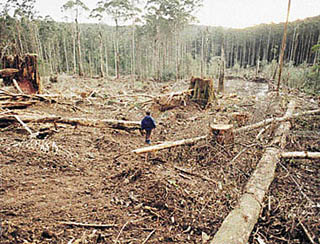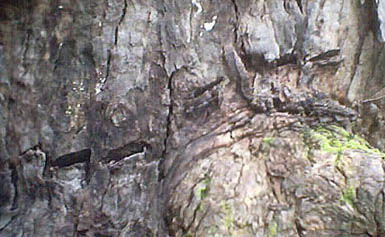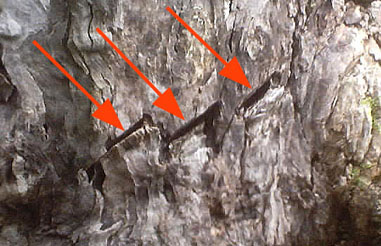
Loss of hollow-bearing trees from Victorian native forest
Many arboreal (tree-dwelling) mammals and birds require hollows in trees;
for sheltering, nesting and sleeping. In areas where hollows are declining
or removed (eg. by clearfell logging) populations of these species decline.
See link to nomination 100.
Veteran trees in the Otways provide hollows
Trees most likely to provide hollows in the Otways are most likely to be veteran trees. Veteran trees are pre-European in age and were left behind after past selective logging operations and wild fires. Veteran trees with hollows are likely to be 200 years old or greater.
Due to past selective logging, many areas in the Otways still contain high stand densities of veteran trees. However the numbers of veteran trees are in decline due to clearfell logging. See nomination (100) for a threatening process.

The Otways are full of areas that have been clearfell logged and not a single tree (alive or dead) has been left standing.
Flora and Fauna Guarantee Act
The Nomination(100) for Loss of hollows-bearing trees from Victorian native forests was listed as a threatening process in the Flora and Fauna Guarantee Act over 11 years ago. No Action Statement has been completed.
Hollow Bearing Trees are Poisoned by Forestry Victoria
The normal practice by Forestry Victoria is to kill large veteran trees to allow more sunlight onto an area clearfell logged. If the veteran tree is not cut down then a poison such as round-up is often used. Notches are cut into the trunk of the tree and injected with poison. The tree dies quickly.
The photos below were taken of the same tree that was poisoned in the West Barwon catchment.

Tree alive after clearfell logging 1997 (left), and tree dead after poisoning
(right). The photo of the dead tree was taken in 2002. The dead tree is
now surrounded by wattle regeneration (virtually a monoculture) after
clearfell logging that was done in 1997.

Axe marks where tree was poisoned.

Arrows point to axe marks where tree was poisoned.
Retention of habitat trees after clearfell logging is a myth.
Habitat trees or veteran trees are used by the native forest logging industry as public relations tool to deceive the community into thinking flora and fauna values are being protected by the retention of habitat (hollow bearing) trees. In reality the native forest logging industry regards the retention of habitat trees as a problem due to:
- Habitat trees are a health and safety issue for logging contractors.
A report by the Eden Logging Investigation and Training Team (ELITT)
recommends that the retention of habitat trees (hollow bearing trees)
in areas clearfell logged is a hazard for loggers. The ELITT accident
investigation work has indicated that the increased retention of trees
in areas clearfell logged in Southern NSW has created a less safe working
environment for loggers. (See Examination of Log Harvesting and Haulage
Arrangements, April 2002 )
- The retention of habitat trees suppresses the growth of an even age stand of young trees due to shade cast by remaining standing trees.
The failure to retain hollow bearing trees is a breach of the Code of Forest Practices for Timber Harvesting and the Flora and Fauna Guarantee Act(See nomination 100).
Relevant Links
See also Old Growth Forests
Don't know the meaning of a word? Check the glossary.